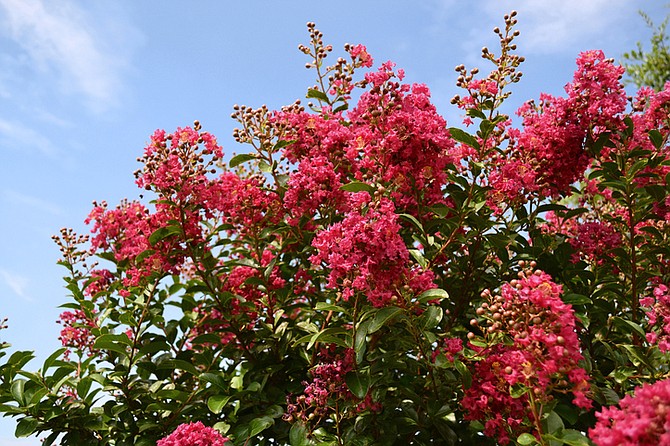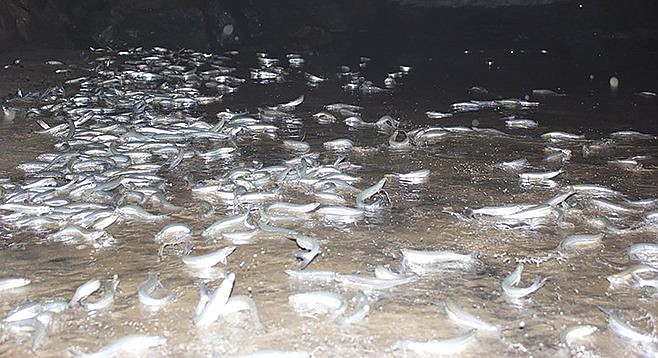 Facebook
Facebook
 X
X
 Instagram
Instagram
 TikTok
TikTok
 Youtube
Youtube

Crape Myrtles are in bloom around San Diego this month through the end of summer. This smallish, vase-shaped tree blossoms in colors ranging from white or pale pink to lavender, red, and blue. Lilac of the South is one of the nicknames given to this native tree of China because of its popularity in the warmer parts of the U.S.
Summer Solstice, the time when the sun reaches its northernmost point in the sky, occurs this year at 8:32 p.m. on Sunday, June 20. The summer solstice not only marks the beginning of summer for the Northern Hemisphere; it also means that the daylight hours are maximized. San Diegans now enjoy approximately 14 hours of daylight, in contrast to the meager 10 hours or so we experience in December. Anytime this week, try checking your shadow at 12:50 p.m. (the local daylight time in San Diego currently equivalent to astronomical noon). The sun is then only 10 degrees south of the straight-up direction and casts near-vertical shadows. A lesser-known consequence of the summer solstice is that our twilight periods are longer than usual. Evening and morning twilight periods are now lasting more than 90 minutes.
June's Full Moon occurs Thursday, the 24th. Watch as it arcs upward into the darkening eastern sky, starting some 15 minutes after the time of sunset. June's full moon has been called the "rose moon," "strawberry moon," or "honey moon" because of its tinted color. When seen from a northern latitude such as our own, the June full moon traces a low-lying nightly path across the sky, very similar to the sun's daytime, low-lying path at the winter solstice. At such low positions the moon's light tends to be filtered and reddened by its passage through the atmosphere, producing a warm-tinted color.
June's Lowest Tides are for early risers only! Check out the local tidepool life without hordes of other people around. Friday, June 25, features a minus -1.96-foot tide at 4:56 a.m. Thursday, June 24, brings a minus -1.91-foot tide at 4:09 a.m., with early dawn light in the sky.

Grunion Runs are most likely to occur near midnight on June 23-24. This corresponds to one to two hours after highest nocturnal tide, two to four days after the date of full moon. The small, silvery grunion tend to spawn on wide, gently sloping beaches such as Silver Strand, Mission Beach, Pacific Beach, La Jolla Shores, and Del Mar. California law allows the taking of grunion in summer by those possessing a state fishing license. The grunion must be caught by the hands only and should be eaten (not wasted).
Look for the Big Dipper hanging straight down in the northwest. Its bottom two stars, the Pointers, point lower right toward modest Polaris, the end of the Little Dipper's handle.
This is the time of year when, at the end of twilight, the Little Dipper floats straight up from Polaris — perhaps like a helium balloon escaped from some June evening party. Through light pollution or moonlight, all you may see of the Little Dipper are Polaris at its bottom and Kochab, the lip of the Little Dipper's bowl, at the top. The rest of its stars are fairly dim at 3rd to 5th magnitude.
The above comes from the Outdoors listings in the Reader compiled by Jerry Schad, author of Afoot & Afield in San Diego County. Schad died in 2011. Planet information from SkyandTelescope.org.


Crape Myrtles are in bloom around San Diego this month through the end of summer. This smallish, vase-shaped tree blossoms in colors ranging from white or pale pink to lavender, red, and blue. Lilac of the South is one of the nicknames given to this native tree of China because of its popularity in the warmer parts of the U.S.
Summer Solstice, the time when the sun reaches its northernmost point in the sky, occurs this year at 8:32 p.m. on Sunday, June 20. The summer solstice not only marks the beginning of summer for the Northern Hemisphere; it also means that the daylight hours are maximized. San Diegans now enjoy approximately 14 hours of daylight, in contrast to the meager 10 hours or so we experience in December. Anytime this week, try checking your shadow at 12:50 p.m. (the local daylight time in San Diego currently equivalent to astronomical noon). The sun is then only 10 degrees south of the straight-up direction and casts near-vertical shadows. A lesser-known consequence of the summer solstice is that our twilight periods are longer than usual. Evening and morning twilight periods are now lasting more than 90 minutes.
June's Full Moon occurs Thursday, the 24th. Watch as it arcs upward into the darkening eastern sky, starting some 15 minutes after the time of sunset. June's full moon has been called the "rose moon," "strawberry moon," or "honey moon" because of its tinted color. When seen from a northern latitude such as our own, the June full moon traces a low-lying nightly path across the sky, very similar to the sun's daytime, low-lying path at the winter solstice. At such low positions the moon's light tends to be filtered and reddened by its passage through the atmosphere, producing a warm-tinted color.
June's Lowest Tides are for early risers only! Check out the local tidepool life without hordes of other people around. Friday, June 25, features a minus -1.96-foot tide at 4:56 a.m. Thursday, June 24, brings a minus -1.91-foot tide at 4:09 a.m., with early dawn light in the sky.

Grunion Runs are most likely to occur near midnight on June 23-24. This corresponds to one to two hours after highest nocturnal tide, two to four days after the date of full moon. The small, silvery grunion tend to spawn on wide, gently sloping beaches such as Silver Strand, Mission Beach, Pacific Beach, La Jolla Shores, and Del Mar. California law allows the taking of grunion in summer by those possessing a state fishing license. The grunion must be caught by the hands only and should be eaten (not wasted).
Look for the Big Dipper hanging straight down in the northwest. Its bottom two stars, the Pointers, point lower right toward modest Polaris, the end of the Little Dipper's handle.
This is the time of year when, at the end of twilight, the Little Dipper floats straight up from Polaris — perhaps like a helium balloon escaped from some June evening party. Through light pollution or moonlight, all you may see of the Little Dipper are Polaris at its bottom and Kochab, the lip of the Little Dipper's bowl, at the top. The rest of its stars are fairly dim at 3rd to 5th magnitude.
The above comes from the Outdoors listings in the Reader compiled by Jerry Schad, author of Afoot & Afield in San Diego County. Schad died in 2011. Planet information from SkyandTelescope.org.
Comments